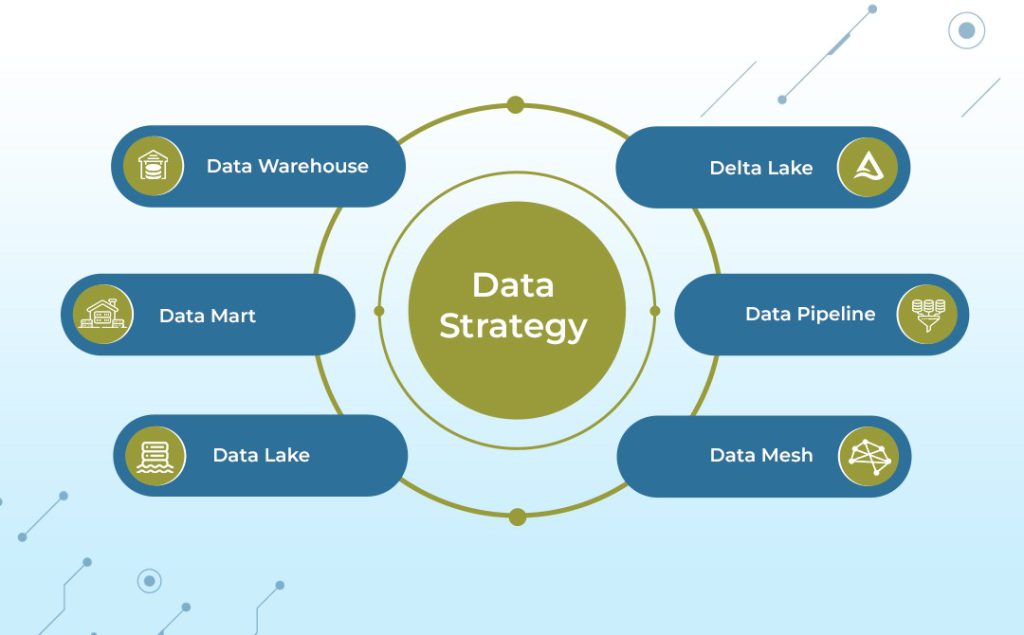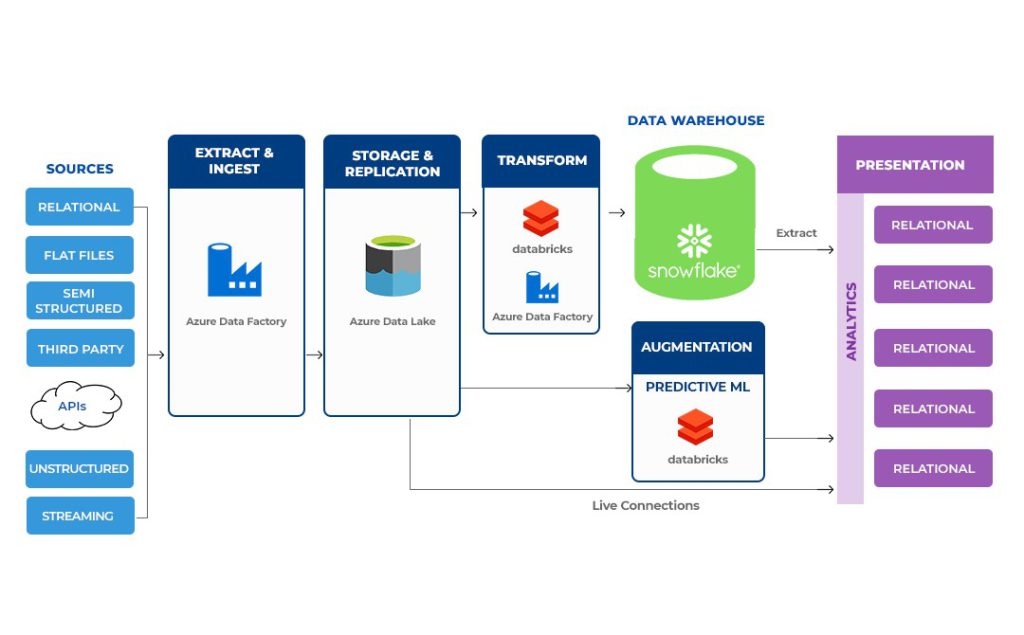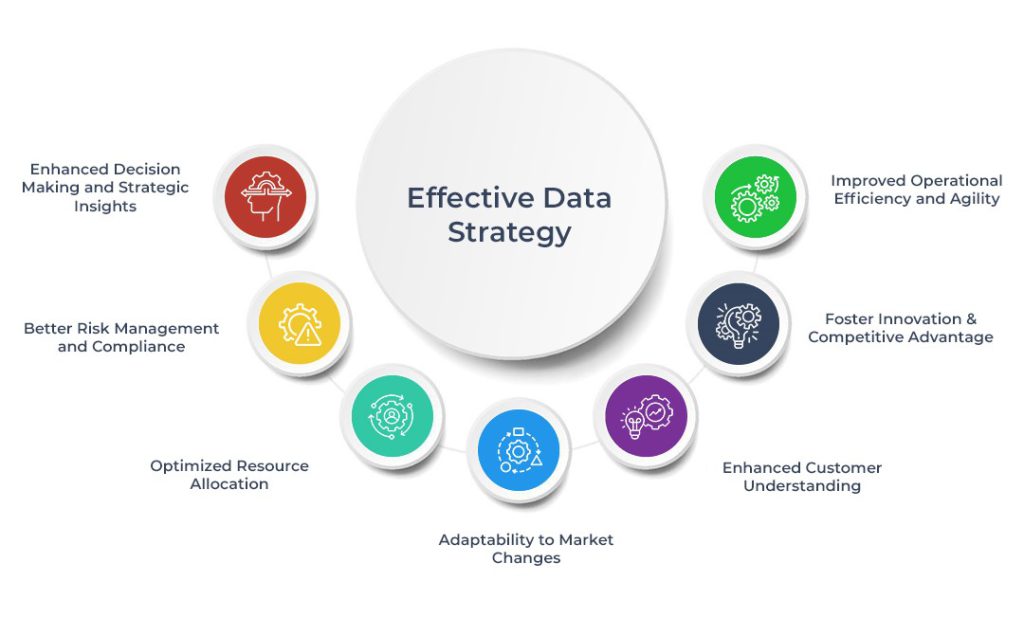What is a Data Strategy? 6 Key Elements to Grow Your Business
Today, every business is collecting data. But collecting data is not enough. You need a data strategy to make sense of it. Without a good data management strategy, you’ll be lost in a sea of numbers. I’m going to explain to you how to build a simple, yet powerful data strategy—one that works for your business without being too complex.
The 6 Elements
 You want big success in your business. But you need small steps first. You need data strategy. Without it, your data all over the place. Hard to find. Hard to use. But with good strategy, everything clear. You know what to do. Step by step.
You want big success in your business. But you need small steps first. You need data strategy. Without it, your data all over the place. Hard to find. Hard to use. But with good strategy, everything clear. You know what to do. Step by step.
- Data Warehouse
(Big Room Where Data Lives)
Think of data warehouse like big storage room. You put all your important data in one place. Imagine you run small shop. You sell things every day. You don’t want to look in 5 or 10 places to find your sales, right? You need one big room where everything is. Easy to find. Fast to check.
This is what data warehouse does. It holds all your business data in one place.
- Sales data? Here.
- Customer data? Here.
- Employee data? Here.
Everything together. No confusion. No searching in many places. If you use tools like Snowflake or Databricks? Even better. You see your data fast. No waiting.
You get: One place for all your data. Easy to find. No searching.
- Data Mart
(Little Room for Each Team)
Now, data mart is little room inside big room. Each team gets own little room. Maybe you have marketing team. They don’t need all company’s data. They just need their marketing numbers. So, they get their own data mart.
Same for sales team. Same for HR. Each team gets what they need. They don’t look at other things. This way? They find answers fast. No looking at data they don’t need.
- Marketing team? Gets marketing data.
- Sales team? Gets sales data.
- HR team? Gets HR data.
You get: Each team finds what they need. Fast. No extra data to confuse.
- Data Lake
(Big Pool for Messy Data)
Now, data lake is different. It’s like big pool of water. You throw all kinds of data in here. Doesn’t matter if it’s messy or not organized. You just store it. Maybe you don’t need it today, but you keep it here for later.
Let’s say you run hospital. You have:
- Patient records,
- Medical images,
- Research data.
You don’t know what you need right now, but you store everything in the data lake. It’s big and can hold anything. But be careful! If you don’t organize, it becomes data swamp. Messy. Hard to use. So, you need rules to keep it clean. These rules are called data governance.
You get: Big place to store all kinds of data. But keep it clean, or it becomes messy.
- Delta Lake
(Fix Mistakes in Data)
Sometimes, data goes wrong. Maybe you update something, but mistake happens. A Delta Lake helps fix this. It makes sure data is always correct, even if mistake happens.
For example, you run online store. You sell products every day. If your data is wrong, it’s big problem. Delta Lake makes sure your numbers always correct. No mistakes. It fixes things if something goes wrong.
- If data is wrong? Delta Lake fixes it.
- If update goes bad? Delta Lake keeps it correct.
You get: Delta Lake keeps your data correct, even if something goes wrong.
- Data Pipeline
(Road for Data to Travel)
Data pipeline is like road. Data must travel. It moves from one place to another. Maybe you have data from website. Or from sales. Or from social media. Data pipeline helps it move. It goes to data warehouse. Or data mart.
If road is good, data moves fast. If road is bad, data gets stuck. So, good data pipeline is very important. It helps data move smooth. Fast.
- Website data? Moves to warehouse.
- Social media data? Moves to warehouse.
- Sales data? Moves to warehouse.
You get: Data moves smooth. Always ready for you.
- Data Mesh
(Each Team Takes Care of Their Own Data)
Data mesh is different. It is like giving each team their own box. They take care of their data. They don’t wait for others. This makes work faster.
For example, marketing team has their data. Sales team has their data. They control it. They don’t wait for IT team to help. If they need to share, they can. But they don’t need to wait.
- Marketing team controls marketing data.
- Sales team controls sales data.
You get: Each team controls own data. No waiting. Everything faster.
Why Data Strategy?
Imagine you are driving car. But your windshield is dirty. You can’t see road clearly. You guess where to turn. You guess where other cars are. This is how business feels without data strategy. You try to make decisions, but you don’t see clearly. Data is everywhere, but you can’t use it well.
A data strategy cleans the windshield. It shows you clear road. You see where to go. You see problems before they happen. You make decisions faster. You save time. You don’t depend on guessing.
But without data strategy, you face many problems:
- Can’t Make Decisions on Time
If your data is scattered, decision-making is slow. You don’t know what’s happening in your business. You guess. You hope it works. But you don’t have real data in front of you. A data strategy makes decision-making faster. You don’t have to wait. You see what’s happening now.
- Can’t Predict Future Trends
Without good data strategy, you don’t see trends. You don’t see new patterns. You don’t know where the market is going. You miss opportunities. You can’t predict what your customers want. A good strategy helps you see these things before they happen. You can act fast.
- Miss Out on New Tech
You don’t want to miss new technologies like GenAI. But without a clear data plan, you can’t implement these advanced tools. You fall behind competitors who are using new tech. A good data strategy helps you stay updated.
- Too Much Dependence on One Vendor
If you don’t have a strategy, you might depend too much on one vendor. This is risky. What if the vendor changes price? What if they shut down? A good data management strategy helps you use different tools. No over-reliance on one company.
- Messy Metrics and KPIs
Without good data governance strategy, everyone uses different numbers. One team says sales are up. Another says sales are down. Which is true? You don’t know. A good strategy gives you clear definitions. Everyone uses the same metrics.
- Data Stuck in Silos
If your data is stuck in different places, teams can’t work together. Marketing has their data. Sales have their data. But they don’t share. This slows down everything. With a good data management strategy, data flows between teams. No more silos.
- Too Much Time Spent on Raw Data
You spend too much time preparing data. Cleaning data. Organizing data. This wastes time. A good data strategy automates these things. So, you spend less time on raw data and more time on real work.
- Data Quality Problems
If your data is not clean, you make bad decisions. Bad data leads to bad outcomes. A data strategy ensures your data is high quality. You can trust it.
- IT Team Overloaded
Without a clear plan, everyone runs to IT for help. IT spends too much time fixing data problems or pulling reports. This slows down the whole company. A data strategy gives teams the tools they need. No need to depend on IT for every little thing.
 A modern data strategy relies on an effective data architecture set-up. The above image represents some of the tool options for each phase of the data lifecycle including extract and ingest, data storage & replication, data transformation, data warehouse, and data visualization.
A modern data strategy relies on an effective data architecture set-up. The above image represents some of the tool options for each phase of the data lifecycle including extract and ingest, data storage & replication, data transformation, data warehouse, and data visualization.
Advantages of an Effective Data Strategy
 Now, let’s talk about why you should care about a good data strategy. What do you get when you have one? You get a lot. It changes everything for your business.
Now, let’s talk about why you should care about a good data strategy. What do you get when you have one? You get a lot. It changes everything for your business.
- Make Better Decisions, Faster
When your data is in one place, you see your business clearly. No guessing. You know what’s working and what’s not. You make decisions faster. You don’t wait for reports. You don’t wonder if the data is right.
- Save Time and Work Smarter
With a good data strategy, everyone knows where to find data. No more searching. No more confusion. You save time. If something changes in the market, you can react fast. You don’t waste time trying to find the right data.
- Stay Ahead of Competitors
When you use data well, you can try new things. You can innovate. You can test new ideas quickly. If something works, great. If not, you try again. This keeps you ahead of competitors. You’re always moving forward.
- Keep Your Business Safe
A data governance strategy helps you avoid trouble. If you don’t follow rules, you might face legal problems. But with a strong data plan, you know your data is safe. You follow laws. No need to worry.
- Understand Your Customers Better
A good data strategy lets you see what your customers like. You take data from different places (like sales, social media) and put it together. You see a full picture. This helps you give customers what they want. Happy customers come back.
- Spend Money Wisely
A good data strategy shows you where to spend your money and time. You know which parts of your business need more attention. You don’t waste money on things that don’t matter. You focus on what’s important.
- Adapt to Changes Fast
The market always changes. But with a good data management strategy, you can change too. You see what’s happening in real-time. You don’t get stuck doing the same thing. You can adjust your business quickly and keep moving forward.
Small Steps, Big Success
Like Neil Armstrong didn’t get to moon without plan, your business won’t grow without good data governance strategy. It’s not about fancy tools. It’s about making sure your data is organized, easy to use, and correct.
Focus on these 6 things. They will help you build strong foundation for your business. You will make better decisions, save time, and stay ahead of competition.
- Keep data organized.
- Make data easy to use.
- Make sure data correct.
You get: A strong data strategy is like engine for your business. It helps you grow faster and stay competitive.








 You want big success in your business. But you need small steps first. You need data strategy. Without it, your data all over the place. Hard to find. Hard to use. But with good strategy, everything clear. You know what to do. Step by step.
You want big success in your business. But you need small steps first. You need data strategy. Without it, your data all over the place. Hard to find. Hard to use. But with good strategy, everything clear. You know what to do. Step by step. A modern data strategy relies on an effective data architecture set-up. The above image represents some of the tool options for each phase of the data lifecycle including extract and ingest, data storage & replication, data transformation, data warehouse, and data visualization.
A modern data strategy relies on an effective data architecture set-up. The above image represents some of the tool options for each phase of the data lifecycle including extract and ingest, data storage & replication, data transformation, data warehouse, and data visualization. Now, let’s talk about why you should care about a good data strategy. What do you get when you have one? You get a lot. It changes everything for your business.
Now, let’s talk about why you should care about a good data strategy. What do you get when you have one? You get a lot. It changes everything for your business.



